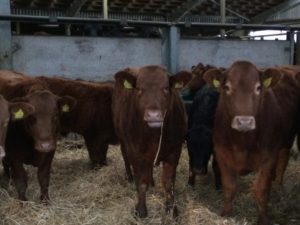The Benefit Of A Dry Lie
1 February 2017 When you snuggle down in bed tonight just think how cold you would be by morning if you wet the bed several times during the night. Unpleasant as it sounds, this is exactly what happens to calves, both artificially reared and suckled calves.
When you snuggle down in bed tonight just think how cold you would be by morning if you wet the bed several times during the night. Unpleasant as it sounds, this is exactly what happens to calves, both artificially reared and suckled calves.
In addition to the obvious risk of infectious diseases (eg scour, navel ill) damp bedding also has a marked effect on the critical temperature of the calf, forcing it to use more energy to keep itself warm. In addition wet bedding –
- Makes the belly and legs of the calf wet, cooling it even more and diverting more energy away from growth.
- Increases the relative humidity in the shed producing a damp rather than a dry cold.
- A high relative humidity increases the survival of disease organisms, particularly pneumonia and scour and hence the challenge the calf faces.
- Having to use more energy to keep itself warm, calves will grow slower and will have a lower resistance to disease.
- Combined the risk of ill health is significantly increased.
Artificially Reared Calves
Some points to help improve the dryness of the bed could be –
- Ensure the pen, be it individual or group, has a good slope, channelling liquid out of the pen and out of the shed ASAP.
- Ensure drainage from the drinking area is directly out of the pen, never back through the lying area.
- In a purpose build calf house there is no reason why the pen floor cannot be steeply sloped to maximise drainage eg 1 in 12. This will also force the wet bedding around the feeding area out of the pen where it can be removed regularly.
- An alternative approach would be to have a slatted floor. While this will maximise drainage and keep bedding dry it can give problems when it comes to mucking out. However some companies now produce concrete slats designed specifically for straw bedding which could be suitable where calves are reared in groups.
- Keep surface water to a minimum ie never wash down passageways, individual empty pens etc while there are calves still in the shed.
Suckled Calves
Suckled calves born outdoors will quickly find the most sheltered, dry lie available, often making maximum use of the shelter provided by their mother. When calves under a month old are seen standing, rather than lying, it is a good indication that there are no suitable lying areas available ie it is too wet. This is a good indicator that the herd should ideally be housed, moved to a drier, more sheltered area or bales of straw rolled out.
Calf shelters should be avoided – all they do is concentrate calves into a small area, significantly increasing the risk of diseases such as scour, coccidiosis, etc.
Housed Suckled Calves
Providing a calf refuge – an area which only the calves can reach is the best way to provide calves with a dry bed and potentially save on straw bedding! The easiest way to provide this is using a temporary electric fence wire, hung from baler twine off the roof rafters at about 3 feet above the top of the bedding. The refuge should be just over 4 feet wide, to allow a bale to be easily rolled out along it for bedding. Young calves will immediately use this as it provides both a dry lie and quiet/protection from cows. In many cases the cow and calf will lie either side of the electric fence, as close as they would be in the field.
Basil Lowman, basil.lowman@sac.co.uk
Sign up to the FAS newsletter
Receive updates on news, events and publications from Scotland’s Farm Advisory Service
